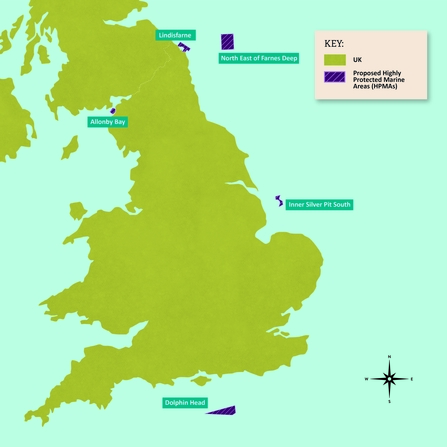Highly Protected Marine Areas (HPMAs) would offer the best possible protections for our seas, by banning development, fishing and other damaging activities. Good for nature, good for people and good for the climate, too.
For decades, our seas have been threatened by overfishing, development and more. Thanks to the campaigning of over 10,000 of our amazing supporters, the Government promised to designate Highly Protected Marine Areas in English Waters. We’re so close now. But we needed help to get them over the line.
The Government was asking for public views on five proposed HPMA sites. We asked you to support our call on the Government to designate all five sites - and 17,000 of you added your support and personal comments. Thank you! We'll be watching the next steps with interest and will keep supporters updated.

Phosphorescent sea pen ©Paul Naylor www.marinephoto.co.uk
What will HPMAs do for people, nature and climate?
Discover the benefits of HPMAs using the dropdowns below.
People
HPMAs will offer many benefits for people. They will provide excellent places for us to experience underwater wildlife. Our mental and physical health will benefit from spending time in and near HPMAs. By encouraging nature tourism and providing jobs for local people, coastal HPMAs will provide positive impacts to communities. Fishers in surrounding areas will find more fish to catch, as populations recover and spread to surrounding areas. HPMAs will also safeguard our seas for future discoveries by scientists and students.
Even those who live far away from the sea will benefit from knowing these special places are properly protected. Every second breath we breathe comes from the ocean - even more important for us to take care of it!
Nature
Our seas are damaged, and wildlife at risk, due to decades of overexploitation and development. The science is clear - by protecting all wildlife and habitats from damaging activities, HPMAs will give our seas the best chance to recover. This will provide the benchmark against which to measure the health of our seas and other marine protected areas.
Climate
HPMAs will help to combat climate change by protecting and restoring species and habitats which store carbon. By safeguarding coastal habitats, they will also help protect our coasts from erosion and flooding.
HPMAs will also help marine life to adapt to climate change. For example, storm events are expected to increase with climate change and we already know that wildlife in well-managed marine protected areas can recover from storm events faster than in unprotected areas.
Where are the proposed HPMAs?
Learn more about these special places using the dropdowns below!
Allonby Bay, off Cumbria’s coast
Allonby Bay is an important inshore area, at the mouth of the Solway Firth.
Why is it so special?
It includes reefs of blue mussels and some of the best examples of honeycomb worm reefs in the UK. The habitats also store significant amounts of carbon and provide flood and coastal protection.
Wildlife found here
Allonby Bay is a spawning area for thornback rays, and thought to be an important breeding area for harbour porpoise. Seabirds such as guillemots frequently feed here.
Inner Silver Pit South, in the southern North Sea
Inner Silver Pit South is a unique underwater glacial valley. It plummets to almost 100m deep and the seabed is alive with brittlestars.
Why is it so special?
It is particularly special thanks to its reefs, which are formed by worms and other animals. But scallop dredging here has damaged these delicate reefs.
Wildlife found here
Inner Silver Pit South is a spawning ground for fish. This which means seals and seabirds, including guillemots, black-legged kittiwakes and northern gannets, are attracted to the area.
Dolphin Head, in the English Channel
Dolphin Head is a diverse area offshore, approximately 55km from the Sussex coast.
Why is it so special?
The tide dominates this area, as it is influenced by swell from the Atlantic Ocean. However, years of damaging fishing activities have damaged the seabed.
Wildlife found here
The wonderful range of species found here, including lobsters, eels, and reef-building worms, attract dolphins and seabirds to feed.
North-East of Farnes Deep, in the northern North Sea
North-East of Farnes Deep is an area offshore with sediments teeming with life.
Why is it so special?
This area has subtidal sediments important for carbon storage, ocean quahogs, starfish, sea pens, anemones and fish.
Wildlife found here
As well as the above wildlife, dolphins, whales and harbour porpoises use this area. It’s a fantastic hotspot that deserves protection!
Lindisfarne, off Northumberland’s coast
Lindisfarne is an inshore area, including the outer Farne Islands.
Why is it so special?
In summer, the coastal habitats are important for breeding seabirds such as little terns and puffins, while in winter it is a top destination for overwintering birds.
Wildlife found here
Grey seals roam the rich waters, with fluffy pups born in autumn. 3% of the annual British seal pups are born at this Northumberland colony. The wildlife here is spectacular but degraded.
A map of all the Highly Protected Marine Areas

More about HPMAs
Highly Protected Marine Areas (HPMAs) will be a new type of marine designation to protect and restore nature.
This means that all damaging activities such as fishing, anchoring, dredging and construction will be banned in HPMAs.
But don’t worry, they will not be ‘no-go zones’ for people! We will all still be able to enjoy our seas through non-damaging activities such as surfing, scuba diving, snorkelling and kayaking.
What will HPMAs protect?
HPMAs will protect all wildlife within their boundaries through a ‘whole-site approach’. This means that the ecosystem, habitats and species, abiotic elements, and their supporting ecosystem function and processes are all protected. If it is in the HPMA it will be protected! This includes the seabed, the water column and the sea surface.
How are HPMAs different to existing marine protected areas?
Existing Marine Protected Areas (MPAs) are important designations, but their purpose is just to maintain the current, often degraded state. They also have a ‘protected feature approach’. This means they only protect certain species and habitats within their boundaries. In these areas, only some damaging activities are prevented and only in some locations.
But in Highly Protected Marine Areas, all damaging activities would be banned within the whole site. This new type of designation will allow nature to properly recover. HPMAs would set a high bar against which we can measure other protected areas.





